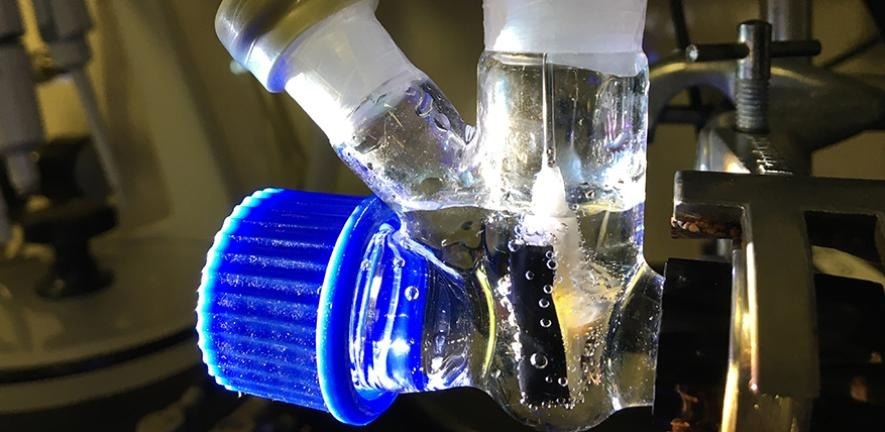Scientists have developed a solar-powered technology that transforms carbon dioxide and water into liquid fuels that can be immediately added to the engine of a car as a drop-in fuel.

A photoreactor with an artificial leaf working under solar irradiation. Image Credit: Motiar Rahaman
The University of Cambridge researchers used photosynthesis to transform CO2, water, and sunlight into multicarbon fuels, ethanol, and propanol, in a single process. These fuels have a high energy density and are simple to store and transfer.
Unlike fossil fuels, these solar fuels emit no carbon and are totally renewable; also, unlike most bioethanol, they do not divert agricultural land from food production.
While the technology is still in the lab, the researchers believe their “artificial leaves” are a vital step toward moving away from a fossil-fuel-based economy. The findings were published in the journal Nature Energy.
Because it is derived from plants rather than fossil fuels, bioethanol is promoted as a cleaner alternative to petrol. The majority of cars and trucks on the road now run on petrol containing up to 10% ethanol (E10 fuel).
The United States is the world’s biggest bioethanol producer: over 45% of all corn farmed in the United States is utilized for ethanol production, according to the United States Department of Agriculture.
Biofuels like ethanol are a controversial technology, not least because they take up agricultural land that could be used to grow food instead.
Erwin Reisner, Professor, Yusuf Hamied Department of Chemistry, University of Cambridge
Erwin Reisner headed the study.
For several years, Reisner’s research team at the Yusuf Hamied Department of Chemistry has been employing artificial leaves to generate sustainable, zero-carbon fuels inspired by photosynthesis (the process by which plants convert sunlight into food).
Until recently, these artificial leaves have only been capable of producing simple chemicals like syngas, a mixture of hydrogen and carbon monoxide used to produce fuels, pharmaceuticals, plastics, and fertilizers. However, for the technique to be more practical, it must be capable of producing more complicated molecules directly in a single solar-powered step.
The artificial leaf can now effectively produce pure ethanol and propanol without the need for a syngas production step.
The scientists created a copper and palladium-based catalyst. The catalyst was modified such that the artificial leaf could make more complex chemicals, namely the multicarbon alcohols ethanol and n-propanol. Both alcohols have a high energy density and are easily transported and stored.
Other researchers have been able to create comparable chemicals using electrical power, but this is the first time such complex chemicals have been created with an artificial leaf using energy from the sun.
Shining sunlight on the artificial leaves and getting liquid fuel from carbon dioxide and water is an amazing bit of chemistry. Normally, when you try to convert CO2 into another chemical product using an artificial leaf device, you almost always get carbon monoxide or syngas, but here, we’ve been able to produce a practical liquid fuel just using the power of the Sun. It’s an exciting advance that opens up whole new avenues in our work.
Dr. Motiar Rahaman, Study First Author, University of Cambridge
At the moment, the device is merely a proof of concept, with only minimal efficiency. The researchers are attempting to improve the light absorbers’ ability to absorb sunlight, as well as the catalyst’s ability to turn more sunlight into fuel. Additional research will also be necessary to scale the device so that it can create significant amounts of fuel.
Even though there’s still work to be done, we’ve shown what these artificial leaves are capable of doing. It’s important to show that we can go beyond the simplest molecules and make things that are directly useful as we transition away from fossil fuels.
Dr. Motiar Rahaman, Study First Author, University of Cambridge
The study was funded in part by the European Commission Marie Skłodowska-Curie Fellowship, the Cambridge Trust, and the Winton Programme for the Physics of Sustainability. Erwin Reisner is a Fellow and Motiar Rahaman is a Research Associate of St John’s College, Cambridge.
Journal Reference
Rahaman, M., et al. (2023) Solar-driven liquid multi-carbon fuel production using a standalone perovskite–BiVO4 artificial leaf. Nature Energy. doi.org/10.1038/s41560-023-01262-3.